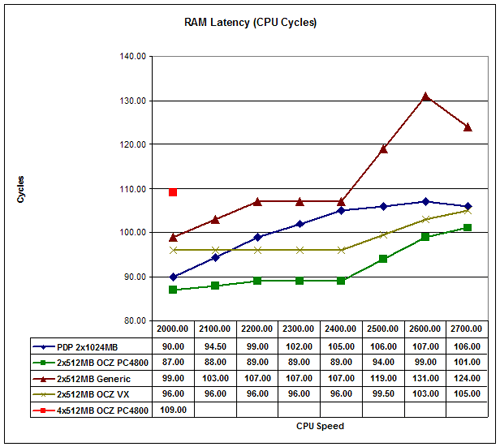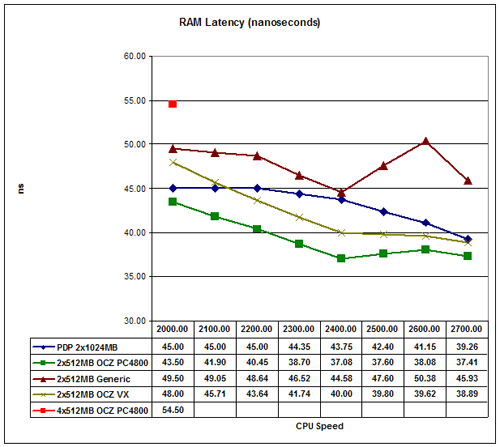Investigations into Athlon X2 Overclocking
by Jarred Walton on December 21, 2005 12:00 PM EST- Posted in
- CPUs
RAM Latency
In the Venice article, we talked quite a bit about memory latencies and how they affect performance. Since we're using four different types of RAM this time, we will most likely see more variation in RAM latencies. However, even a relatively large difference of 20% will often have less than a 5% impact on real world application performance. Another item to pay attention to is the difference between higher bandwidth vs. lower latencies that the OCZ VX and EL Platinum represent.
CPU-Z includes a latency.exe program that we used to get these values, and we selected the score in the bottom-right of the table. This position represents a 32MB data set with a 512 KB stride size, and the results are reported in CPU cycles. We have two charts again, the first in CPU cycles and the second in nanoseconds. Since cycle time decreases as clock speed increases, we would pay a bit more attention to the results in nanoseconds. However, the elapsed CPU cycles are also important as they represent wasted CPU time. If cache misses are relatively constant - and they are - then the higher the RAM latency is in CPU cycles, the less efficient the processor becomes. Here are the results.
Since all of the various configurations ran successfully with 1T timings, latencies stay relatively close - even the value RAM isn't that far behind the fastest RAM used. We couldn't get results for 4x512MB except at stock clock speeds, but comparing the scores at 10x200 is still possible. You can clearly see how much the 2T command rate impacts performance, which brings up another point: a lot of value RAM is not guaranteed to run at 1T command rates. This same value RAM required 2T command rate with the Venice chip for the 9x300 setting, even though it was still running below its rated DDR400 speed. Your mileage may vary.
Something else that we failed to mention last time was the numerous in-between options for RAM. 2.5-3-3-7/8 RAM can be purchased for around $80, give or take. In the $100 to $130 price range, there are many sets of 2x512MB DIMMs rated for 2-3-3-6-1T or 2-3-2-5-1T timings. The difference between CL2 and CL2.5 isn't huge, but it may warrant spending an extra $20. The true performance/overclocking RAM starts at around $120 (Crucial Ballistix - really an awesome deal if you ask me!) and goes up from there to over $200. That's a dramatic price increase on the high-end for what is likely to be a small performance difference, but there is something to be said for the ease of use that expensive RAM offers. Where we had to do some work finding the optimal performance settings on value RAM at the various overclocked speeds (and we really only scratched the surface), the OCZ EL Platinum could usually be left at a DDR-400 setting in the BIOS with 2.5-3-3-7-1T timings. It wasn't optimal in all cases, but it required very little effort to find a stable overclock.
The OCZ VX is definitely held back by the Infinity motherboard. 3.2V is the minimum required voltage for stable 2-2-2-8-1T timings. We were able to reach as high as DDR-452 speeds while maintaining 2-2-2-8 timings, but DDR-460 required 2-3-2-8-1T and DDR-500 required 2-3-3-8-1T timings. Beyond DDR-500, even raising CL to 2.5 didn't help much. OCZ VX is still very fast RAM, but it really needs the best in terms of motherboards to reach its full potential. In the RAM area, we now have two strikes against our selected motherboard.
In the Venice article, we talked quite a bit about memory latencies and how they affect performance. Since we're using four different types of RAM this time, we will most likely see more variation in RAM latencies. However, even a relatively large difference of 20% will often have less than a 5% impact on real world application performance. Another item to pay attention to is the difference between higher bandwidth vs. lower latencies that the OCZ VX and EL Platinum represent.
CPU-Z includes a latency.exe program that we used to get these values, and we selected the score in the bottom-right of the table. This position represents a 32MB data set with a 512 KB stride size, and the results are reported in CPU cycles. We have two charts again, the first in CPU cycles and the second in nanoseconds. Since cycle time decreases as clock speed increases, we would pay a bit more attention to the results in nanoseconds. However, the elapsed CPU cycles are also important as they represent wasted CPU time. If cache misses are relatively constant - and they are - then the higher the RAM latency is in CPU cycles, the less efficient the processor becomes. Here are the results.


Since all of the various configurations ran successfully with 1T timings, latencies stay relatively close - even the value RAM isn't that far behind the fastest RAM used. We couldn't get results for 4x512MB except at stock clock speeds, but comparing the scores at 10x200 is still possible. You can clearly see how much the 2T command rate impacts performance, which brings up another point: a lot of value RAM is not guaranteed to run at 1T command rates. This same value RAM required 2T command rate with the Venice chip for the 9x300 setting, even though it was still running below its rated DDR400 speed. Your mileage may vary.
Something else that we failed to mention last time was the numerous in-between options for RAM. 2.5-3-3-7/8 RAM can be purchased for around $80, give or take. In the $100 to $130 price range, there are many sets of 2x512MB DIMMs rated for 2-3-3-6-1T or 2-3-2-5-1T timings. The difference between CL2 and CL2.5 isn't huge, but it may warrant spending an extra $20. The true performance/overclocking RAM starts at around $120 (Crucial Ballistix - really an awesome deal if you ask me!) and goes up from there to over $200. That's a dramatic price increase on the high-end for what is likely to be a small performance difference, but there is something to be said for the ease of use that expensive RAM offers. Where we had to do some work finding the optimal performance settings on value RAM at the various overclocked speeds (and we really only scratched the surface), the OCZ EL Platinum could usually be left at a DDR-400 setting in the BIOS with 2.5-3-3-7-1T timings. It wasn't optimal in all cases, but it required very little effort to find a stable overclock.
The OCZ VX is definitely held back by the Infinity motherboard. 3.2V is the minimum required voltage for stable 2-2-2-8-1T timings. We were able to reach as high as DDR-452 speeds while maintaining 2-2-2-8 timings, but DDR-460 required 2-3-2-8-1T and DDR-500 required 2-3-3-8-1T timings. Beyond DDR-500, even raising CL to 2.5 didn't help much. OCZ VX is still very fast RAM, but it really needs the best in terms of motherboards to reach its full potential. In the RAM area, we now have two strikes against our selected motherboard.










46 Comments
View All Comments
JarredWalton - Wednesday, December 21, 2005 - link
This may seem like a stupid question, but you did copy the SuperPi executable into two separate folders, right? Otherwise, the two running processes overwrite each others' data and one will always fail. Anyway, I don't find SuperPi to be a very useful stress test compared to Folding@Home, Prime95, and several other utilities; it just doesn't stress the system out that much IMO.Yianaki - Wednesday, December 21, 2005 - link
Yes of course it is in two folders. I realized that the SECOND time I did it Heh.Leper Messiah - Wednesday, December 21, 2005 - link
Thats actually a good thing, my X2 3800 does 2.65 at 1.425 vcore stable a rock. Looks like this x2 test is a good average indicator instead of most reviews which have the nice cherry picked silicon.JustAnAverageGuy - Wednesday, December 21, 2005 - link
Yeah, My Opteron 165 seems to top off at around 2.6GHz with the stock cooler.Araemo - Wednesday, December 21, 2005 - link
If you buy a socket 939 opteron, will it work in a normal NF4/etc mobo?A dual core opteron is tempting if it will work in the standard enthusiast motherboards. Get a nice heatsink and get it nice and toasty, I could turn my heater back off. :) And I hope 2GB RAM sticks go down in price within the next 9 months.. I'm still debating between a sweet laptop or a good overclocker desktop for my next computer, the desktop would be much cheaper, for sure, but it is a pain to take to LAN parties.
JustAnAverageGuy - Wednesday, December 21, 2005 - link
Most NF4 motherboards support the S939 Opteron, yes. Check the manufacturer's site to confirm though.Googer - Wednesday, December 21, 2005 - link
I found it a bit humourous that this http://images.anandtech.com/reviews/cpu/amd/athlon...">graphresembles a tent. It reminded me of the days in high school when kids would get fill in the bubble tests and use the answer sheets to do connect the dot drawings.
I wonder if Jarred had too much time on his hands?
kleinwl - Wednesday, December 21, 2005 - link
If you are going to start testing various cooling systems and how they affect max overclock... go ahead and throw in a Seasonic PSU as well. The Seasonic should be rejecting less heat into the case which may make as much difference in overclock as a more efficent Heat Sink. In any case... try it out please!<Note I have a XP-90, with a Antec SmartPower 2.0, on a venice... and I'm curious how such a case temp difference could affect the overclocking potential>
BigLan - Wednesday, December 21, 2005 - link
quote: Looking at the different RAM options, it's difficult to make a good case for spending tons of money on memory.I've always thought that spending a lot of extra cash on memory was a bad idea. It pretty much shows no improvement in Fear. It's nice to see a review of the everyday stuff.
Puddleglum - Wednesday, December 21, 2005 - link
The results for Fear looked bizarre. After reading some of the charts where 4xAA is used on games like Battlefield2 and FEAR, which would be a nice feature to show off on a high-end system, the numbers reveal marginal performance.I confess, I'm still using a Ti4200, which is only performing well in games because it's not drawing the DX9 stuff, and I've truly been waiting for an ideal video card to come out that's worth purchasing; but the new cards that are out right now are making it easy to sit back and wait for the hardware/software ratio to become a little more price-competitive.
Also, why is the OCZ PC4800 freaking out with BF2 when the CPU is overclocked to 2.1GHz?